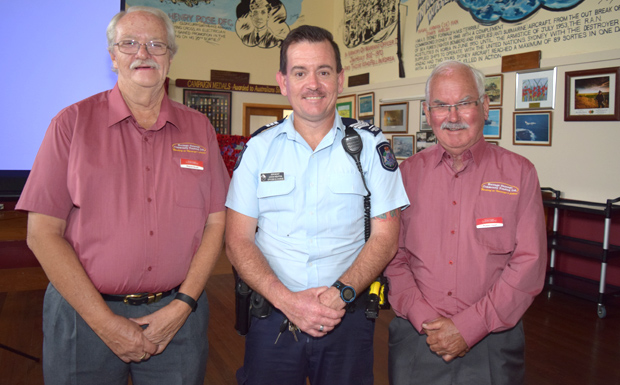
October 24, 2016
The common belief that speed cameras are revenue raisers for the State Government isn’t true, Sgt Jason Newton told an audience of more than 80 people on Saturday afternoon.
“Not one cent of speed camera fines goes into the government’s coffers,” he said.
“Instead that money is used for education and injury rehabilitation programs, and black spot funding to help make our roads safer.”
And while no one ever likes getting a ticket, Sgt Newton also disabused the audience of the myth that police were revenue raising for the Government when they issued traffic infringement notices.
“From our point of view, our aim is to increase the safety of all members of the community through the reduction of road trauma,” Sgt Newton said.
“The riskiest thing most of you will ever do is get into a car, either as a driver or a passenger. So road safety is much more a community issue than just a police issue.
“What police do to make things safer is enforcement, education and helping engineer safer roads through sitting on our local Traffic Advisory Committee, along with Council and Main Roads.”
* * *
Sgt Newton had been invited along to Taras Hall in Nanango to give a talk about road safety and changes to the road rules by Nanango’s Heritage Community Branch.
Bob Head, a director of Heritage Nanango Community Fund’s board, said the idea of having local police give a talk about their work wasn’t new – he’d first seen it on a poster at Clifton, where the Toowoomba Traffic Branch was doing something similar – but it was certainly new for the South Burnett.
So he’d approached Nanango police to see if they’d be willing to talk at a Community Traffic Forum if Heritage picked up the costs, and Nanango’s officer-in-charge had leapt at the opportunity.
“I don’t often get the opportunity to engage with a crowd like this,” Sgt Newton told the audience.
“This forum isn’t just about road rules. It’s about road safety and staying alive and how we police the roads in the Nanango district – and all of you fall into a risk group.”
* * *
Sgt Newton said police now focus on the “Fatal 5” – speeding, drink and drug driving, fatigue, seat belts and distraction – because they had enough data to know these were the major causes of road accidents.
And their emphasis on these things was working, he said.
In 2014, there had been 67 crashes in the Nanango police district, causing one fatality and 26 injuries. But in 2015 this had dropped to 38 crashes, with zero fatalities and 28 injuries. And so far this year, the numbers had dropped again to 17 crashes, with zero fatalities and 11 injuries.
Nanango police put in an average of around 3000 hours every year into enforcing the road rules, Sgt Newton said, and in the same period they had seen the number of driving offences in other categories fall too.
Some of this was due to social change.
Drink driving, for example, was no longer seen as acceptable by most of the community. And recently introduced drug driving tests had made it extremely difficult for anyone who had a trace of illegal drugs in their system to avoid being caught if tested, even if they had used up to a week beforehand.
While some people disliked the idea of seatbelts when they were made compulsory, most people now accepted the fact they were eight times less likely to die in a crash if they were wearing one, and buckled up without a second thought.
But speeding was still a problem, killing or injuring almost 1000 people a year in Queensland.
Alarmingly, statistics showed that as many as half of all crashes were caused by drivers going as little as 10km over the speed limit.
This was why police were now stricter on enforcing speed limits than they had been in the past.
* * *
Two bigger problems that most people weren’t as aware of, though, were fatigue and distraction.
“Fatigue contributed to 25 per cent of all fatalities in the South West Police District between 2011 and 2015,” Sgt Newton said.
“Sleepiness is one of the leading causes of road crashes, and awareness of this needs a cultural change, too.”
Sgt Newton said research data had shown the groups most at risk of suffering a fatigue-related crash were young drivers or those aged over 50; rural drivers; shift workers; and commercial or long-haul drivers.
But combatting it was relatively simple – don’t drive any longer than two hours without taking a break. And make certain you get enough sleep.
It also paid to be alert to the signs of fatigue, such as lane wandering; alternating speeds inadvertently; boredom and restlessness; yawning and drowsiness; head nodding and microsleeps.
“If you notice yourself doing any of these, pull over and have a break or if you’re really tired, take a power nap in your car,” Sgt Newton said.
“It’s this simple, if your head is nodding, you’re at real and immediate risk of killing yourself or someone else.”
* * *
Distraction was another leading cause of road accidents that needed cultural change, but the issue had only come to the fore in recent years with the rise of mobile phones and heavy computerisation in cars.
And of the two, mobile phones seemed the worst because some people found it difficult to turn off their mobiles when driving.
Sgt Newton then showed a short video in which a group of US teenagers happily confessed to using their mobiles while driving, before being introduced to a woman who told how she’d lost both her parents and almost lost her own life when a driver who was using his mobile phone crashed into them:
“Pretty powerful stuff that video, isn’t it?,” Sgt Newton asked the audience when it had finished.
“The law says that if you touch a mobile phone with your hand when you’re driving you’ve committed an offence.
“Now that you’ve all seen this video, I think you can understand why.”
* * *
To lighten the mood, Sgt Newton then went on to run the audience through a quick quiz on road rules and answered many questions from the floor, debunking a number of urban myths in the process and causing a lot of laughter.
Afterwards, guests gathered for afternoon tea.
Bob Head said he was very pleased with the positive audience response the forum had generated, and hoped other South Burnett towns would arrange similar events for their own communities.
“The best way to encourage cultural change is to get the community talking and understanding what the key issues are,” Sgt Newton said.
“Many years ago when we were all young it was common for people to down a six pack and jump behind a wheel, and no one thought twice about it. But these days that’s unacceptable, and that’s an important change in community attitudes that has come about over time.
“We need to change attitudes about speeding, fatigue and distraction too, and this forum is a good step in that direction.”

* * *
Take To The Track Challenge
Drivers who’d like to test their mettle against police – and do it safely and legally – will have their chance this Saturday.
The South Burnett Go-Kart Track on the D’Aguilar Highway south of Nanango will be hosting a “Take To The Track Challenge” charity fundraiser from 9:00am to 5:00pm this Saturday, October 29.
Participants will be able to race against the police to their heart’s content.
There’ll also be road safety displays, an impaired/distracted driving simulator, a drink driving display, mock traffic crash display, a stopping distance display, police vehicles, police equipment, a jumping castle and a sausage sizzle.
Racing on the day will cost $13 per 10 minutes per person, and each person will also require a South Burnett Kart Hire Go Kart licence, which is a one-off cost of $2.
For every race that is sold, 20 per cent will be donated to Police Legacy and the SES.
Sales from the sausage sizzle and jumping castle will also be donated to Police Legacy and SES.
Note: This event was originally scheduled for September 18, but had to be postponed at the last minute due to wet weather.
























“Not one cent of speed camera fines goes into the government’s coffers,” he said.
Camera revenue received during 2013-14 was spent on the following:
https://www.qld.gov.au/transport/safety/fines/speed/cameras/
“Road accident injury rehabilitation projects–blood and blood products – $4.5 million
Improvements to the safety of state-controlled roads – $65.9 million
Road safety education and awareness – $8.1 million
Royal Brisbane and Women’s Hospital – Prevent Alcohol and Risk Related Trauma in Youth Program – $327,000
RACQ DocuDrama Program – $160,000”
If you read the article you will see that “Instead that money is used for education and injury rehabilitation programs, and black spot funding to help make our roads safer.” Which is proven by your information.
If you consider speed camera fines as ‘going into the government’s coffers’ well it’s a voluntary donation.